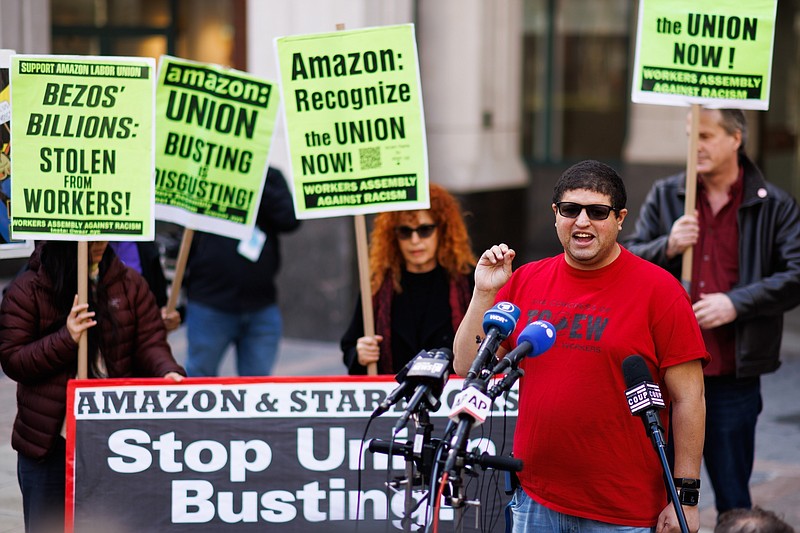The number of Tennessee workers belonging to labor unions has grown over the past two years at the fastest rate of any state in the country.
Fueled by a growth in unionized government employees, building trades and autoworkers, union membership in Tennessee jumped by more than 39% from the pandemic low in 2020 to reach 163,000 members last year, according to the U.S. Bureau of Labor Statistics.
"I think people are beginning to see what labor unions stand for and what they can do for workers, and they are tired of being mistreated or disregarded on the job site," Billy Dycus, president of the AFL-CIO of Tennessee, said in a telephone interview. "Organizing campaigns have accelerated around the state, and as more and more manufacturing and building projects move into our state, you will see even more union support."
For all its gains, however, organized labor still represents only a fraction of workers in Tennessee, especially in the private sector. Last year, 5.5% of all workers across Tennessee were union members, or only about half of the 10.1% share of workers nationwide who belong to a labor union, according to the statistics bureau.
"Most of the growth in unions we're seeing is coming in the public sector, where labor unions represent a much bigger share of workers," Bradley Jackson, president of the Tennessee Chamber of Commerce and Industry, said in a telephone interview. "I think we're also seeing a lot of construction going on in our state, and that's bringing more out-of-state builders with union contracts into Tennessee."
But Jackson said Tennessee remains a right-to-work state where workers have the option of whether or not to join a union even when the majority of workers vote to unionize an employer. Tennessee is one of 28 states with such right-to-work laws, and in the November elections, Tennesseans voted by more than a 2-to-1 margin to enshrine the right-to-work law in the state's constitution.
"Frequently, when we hear about companies looking at locating in Tennessee, one of the first things they want to know is that we are a right-to-work state, " Jackson said. "I think the overwhelming vote to put right-to-work protections in our constitution indicates that most Tennesseans want to be able to represent themselves."
Despite increases in union membership in the past couple of years, the number of union members in Tennessee last year was still nearly 27% below the number of union members in Tennessee 20 years ago, even as the state's workforce has grown by more than 16% over the past two decades.
Two decades ago, 222,000 Tennesseans were union members, representing 9% of the workforce.
The decline in the share of workers represented by organized labor has continued over the past half century across the United States, especially among private-sector workers, who increasingly are changing jobs more often when they don't like their current job.
The percentage of workers belonging to a union in the United States peaked in 1954 at almost 35%, and the number of union members peaked in 1979 at an estimated 21 million, according to the Pew Research Center.
While one-third of all government employees nationwide are represented by labor unions, only 6% of U.S. workers in the private sector belong to a union, according to the statistics bureau. Automation, outsourcing and lower unionization rates in traditional union strongholds, like auto manufacturing, are among the reasons for the steady decline.
Although workers at all of America's Big Three automakers (General Motors, Ford and Chrysler) are represented by the United Auto Workers, foreign automakers operating in the United States such as Volkswagen in Chattanooga, Nissan in Smyrna, Tennessee, and Toyota in Georgetown, Kentucky, are not unionized.
VW workers at the Chattanooga assembly plant narrowly rejected representation by the UAW in unionization votes in both 2014 and 2019.
But as General Motors has expanded operations in Spring Hill, Tennessee, and Ford Motor Co. prepares its biggest investment in company history near Memphis, the UAW is gaining a bigger foothold in Tennessee from the assembly plants and their suppliers.
At the same time, there has been a surge in demand for union representation as the pandemic has eased. Labor shortages have given workers a rare upper hand, which they used to seek higher pay and benefits from their employers.
The statistics bureau reported last week that the median weekly income of union workers last year was $1,216, or 18.2% more than the median weekly pay of $1,029 for nonunion workers.
In the relatively tight labor market, workers are also wanting to make sure they have better work schedules and time off.
In 2022, unionized rail workers protested what they said were increased workloads and inflexible schedules by the major railroads and avoided a strike only when Congress intervened and imposed a deal on the rail unions.
This past week in Chattanooga, members of the International Association of Machinists and Aerospace workers Local 56 voted to go on strike against the Mueller Co. plant. The maintenance mechanics at the water valve production plant said they didn't like a proposed change in their work schedules that could significantly cut overtime for some workers by shifting workers to four 10-hour workdays during the week and three 12-hour workshifts on the weekend. Previously, weekend work was almost entirely on overtime pay.
"A lot of workers are going to lose a lot of overtime, and it looks like they are just trying to cut labor costs," David Bumgard, a 27-year maintenance mechanic at Mueller, said in an interview outside the plant Saturday.
Bumgard said labor unions help protect workers against arbitrary firings and help ensure better pay.
That view appears to be gaining favor. In a survey published in August, Gallup found 71% of Americans said they approve of labor unions, the highest percentage recorded since 1965.
The National Labor Relations Board reported a 53% increase in union representation petitions in its 2022 fiscal year, which ended Sept. 30. A total of 2,510 petitions were filed with the agency, the highest number since 2016.
"In 2022, we saw working people rising up despite often illegal opposition from companies that would rather pay union-busting firms millions than give workers a seat at the table," AFL-CIO President Liz Shuler said in a statement last week about the new union figures. "The momentum of the moment we are in is clear. Organizing victories are happening in every industry, public and private, and every sector of our economy all across the country."
Dan Cornfield, a sociology professor at Vanderbilt University who studies unions, said while unionization rates are declining in some sectors, like telecommunications and clothing manufacturing, they're rising in others, including hospitality, the arts and entertainment. Younger workers are largely driving those efforts, he said.
"Those actions and attitudes could portend a reversal of this long-term decline," Cornfield said.
Workers at more than 270 U.S. Starbucks stores have voted to unionize over the past year, an effort Starbucks opposes. Workers at REI and Chipotle followed with their own unionization campaigns.
Unionization campaigns are also underway at Amazon, Apple and other companies.
But most of those campaigns are in states with a stronger history of labor unions.
Among the 50 states, New York and Hawaii have the highest unionization rates with more than 20% of all workers belonging to unions in those states, according to the statistics bureau. Union membership is the lowest in North Carolina (2.8%) and South Carolina (1.7%).
Tennessee ranked 11th lowest in union membership in 2022 with 5.5% of workers belonging to unions, while Georgia ranked as the seventh-lowest state with 4.4% of workers in labor unions. Union membership across Georgia this past year fell to 200,000, down from 211,000 in 2021, the statistics bureau said.
Men are slightly more likely to be union members than women (10.5% compared to 9.6%). The highest unionization rates were among workers in protective service occupations (34.6%) and in education, training, and library occupations (33.7%).
The Associated Press contributed to this report. Contact Dave Flessner at dflessner@timesfreepress.com or 423-757-6340.
Union membership
rebounds in Tennessee
The number of Tennessee workers belonging to labor unions jumped by more than 39% in the past two years after sinking during the pandemic shutdowns in 2020. Here are the labor union memberships for each year in Tennessee, along with the share of all workers who are members of a union:
— 2022 - 163,000 - 5.5% of all workers.
— 2021- 145,000 - 5.2% of all workers.
— 2020 - 117,000 - 4.4% of all workers.
— 2019 - 135,000 - 4.6% of all workers.
— 2018 - 155,000 - 5.5% of all workers.
— 2017 - 155,000 - 5.7% of all workers.
— 2016 - 158,000 - 5.7% of all workers.
— 2015 - 146,000 - 5.4% of all workers.
— 2014 - 127,000 - 5% of all workers.
— 2013 - 155,000 - 6.1% of all workers.
— 2012 - 124,000 - 4.8% of all workers.
— 2011 - 115,000 - 4.6% of all workers.
Source:U.S. Bureau of Labor Statistics

